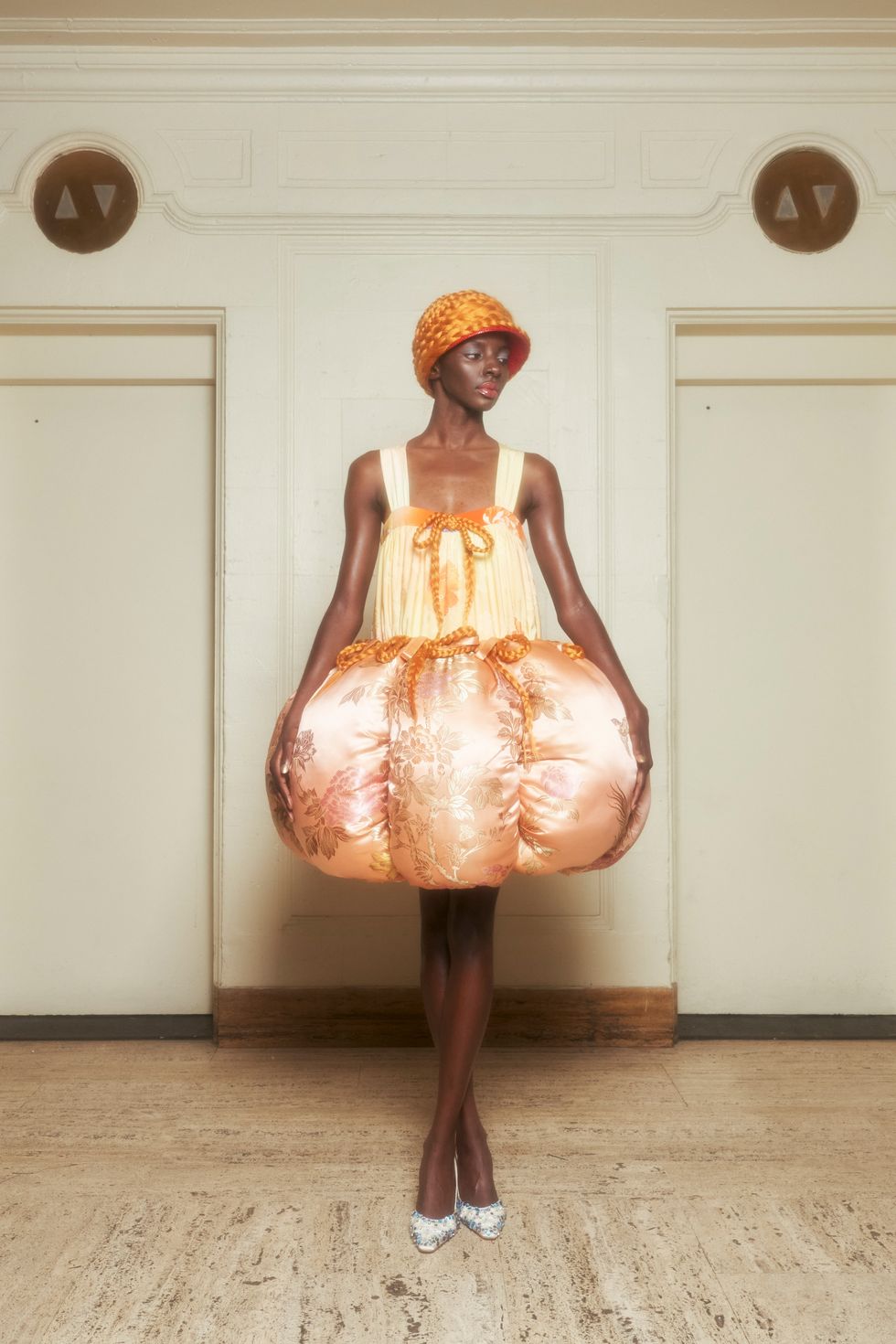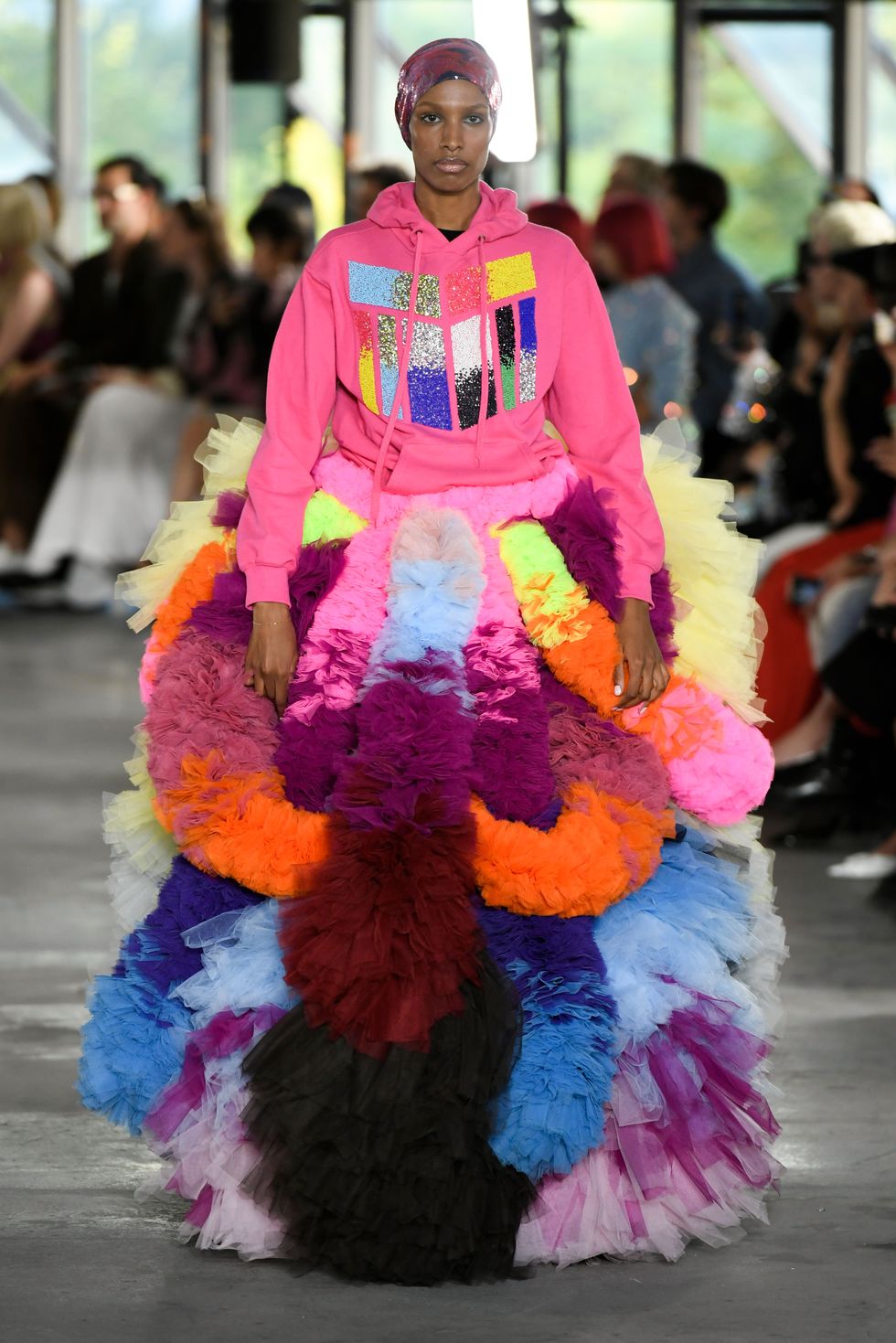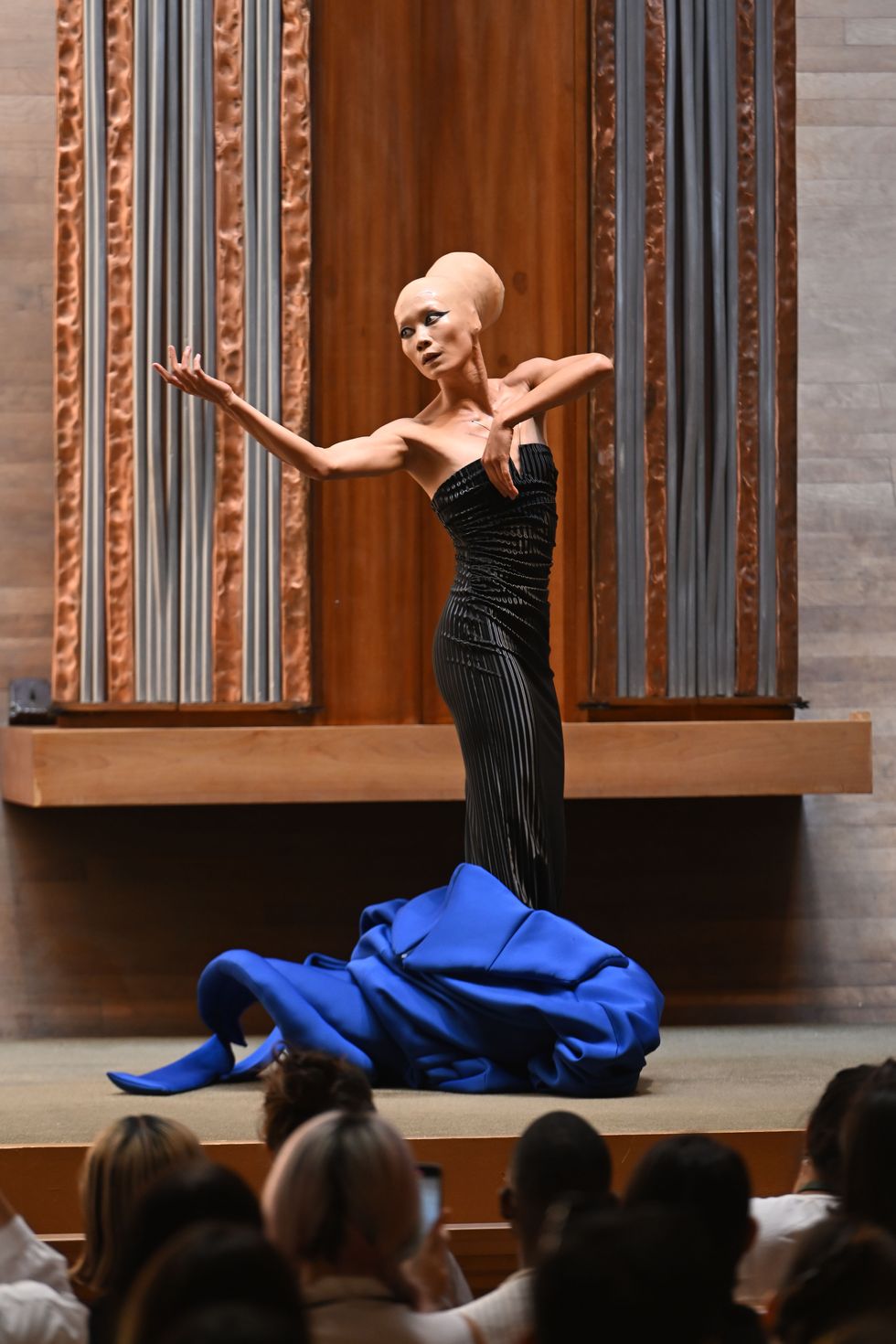Products You May Like
The hottest topic in fashion circles recently? How runway looks have become more over-the-top than ever before. Think: Duran Lantink’s inflatable denim, Marni’s 3-D flowers, Christian Cowan’s giant fur balls, Schiaparelli’s skirt flanked by a supersized lobster, Rick Owens’ pronounced shoulders and sky-high capes that billowed in the wind (ditto for Mugler’s airy displays of silk that looked to be roughly 30 feet long). Germanier and Vaquera showed massive dresses that were so big, they nearly touched guests. You definitely can’t take public transportation in these garments, let alone an Uber or a Lyft. Of course, designers have always had a flair for the dramatic, but they’ve never been quite so eager to lean into the extreme.
“Sitting down?” asks Christian Cowan incredulously, referencing the literal ball-shaped dresses that envelope the wearer’s head, arms, and torso, which he presented last Paris Fashion Week. “No, these are for dancing.” His collection was inspired by the subversive music legend Pete Burns. And the model who wore the black fur ball while Sam Smith performed during the show had issues seeing and walking—but that’s almost beside the point. Cowan’s rotund dresses come in other versions that don’t cover the head. “We are selling more of them than I had anticipated,” the designer says. “They are the ultimate party reveal. Walk in, make your entrance, dance around, and then slip it off to reveal a cute minidress. Usually people like big shoulders and a small waist. I loved that a ball is the opposite of that in every way.”
If you’ve noticed that suddenly everything’s looking a lot more bulbous, you’re not alone. Olivia Cheng of Dauphinette introduced scores of dresses with bell-shaped bottoms and skirts in pillowy, puffy orbs. “They’re not necessarily the most practical, but they are wearable in their own way,” she says. The young designer has graduated from her printed T-shirts and food-inspired resin jewelry and delved further into creating wild silhouettes with volume and heavily embellished pieces covered in whimsical beading and surface decoration. “I really hated the clothes that we were making at one point, because I was trying to make [everything] wearable,” she confesses. “I think committing to more extreme silhouettes makes more sense for me in my mind, at least in terms of being able to better support the brand message and incorporate more of the materials that I want to be working with.”
On the other hand, Germanier presented its most maximalist collection yet for the spring 2024 season, rife with a rainbow of vivid tulle creations and a sea of decadent beads. Designer Kevin Germanier’s work is so extreme, it’s often worn by Björk during her performances. “I see myself as a crazy alchemist-slash-doctor,” he says. “I work with the body, and for me, one thing that I want to stand out is my shapes. I always tell my team, ‘If we keep doing the same shapes and silhouettes again and again, I don’t think we are moving forward. We are not being innovative.’”
Both Dauphinette and Germanier put a heavy focus on upcycling—taking materials from other places and repurposing them into their designs. Of course, that naturally lends itself to allowing for an even more richly layered silhouette, covered in mixed materials that create a sort of topographical fashion wonderscape. And there’s a devoted customer base that craves it, too. “I tried to be more commercial, but then I was like, ‘I’m not on this earth to do something basic.’ Who fucking cares?” Germanier says. “There is a customer that wants to shine, that wants to be crazy, that will spend $2,000 for a skirt.” The designer is increasingly considering his work to be couture.
Of course, fashion has always loved an extreme silhouette. Designers like Rei Kawakubo of Comme des Garçons, Junya Watanabe, and Noir Kei Ninomiya (all under the CDG umbrella) have long been creating visually eccentric, breathtaking shapes that play with the idea of wearability. “The exploration of different ways of expression through clothing, as well as the challenge to create something new, is always at the heart of my creations,” Ninomiya says. Often, his pieces are described by critics as alien or otherworldly. For spring 2024, that meant clouds of wire-y white materials that looked like a fantasia of baby’s breath flowers, or shrouds of black, spike-y, masked fabrics representing a jumble of darkness.
In terms of fashion history, Patricia Mears, the deputy director of The Museum at the Fashion Institute of Technology, cites the court costumes of 18th-century France as early examples of the trend. “You had a dress that was so wide, with panniers, that you had to turn sideways to get through a door, or you had hairstyles that were so extreme, they could catch fire because they were close to the chandeliers,” she says. She also cites chopines, the incredibly high platform shoes (sometimes reaching over 20 inches) that Venetian courtesans would wear. “That was certainly self-promotion,” she says. “You couldn’t not notice a woman walking around Venice who was two feet taller than everybody else.”
After a great run of body diversity that has unfortunately fallen by the wayside, perhaps we’re now entering a new era that seeks to change the idea of what the body looks like completely—with eccentric dressing. “It’s more like, what can we do that is weird?” Germanier says. “Usually, we won’t say, ‘Let’s hide the waist because a girl should always have a tiny waist.’ That is totally stupid. Who said that? Who wrote the rules of shapes and silhouettes? As a designer, it’s actually my role, and my goal is to challenge people’s opinion of what is beautiful and what is not.”
You only have to take a subtle glance at Bad Binch TONGTONG’s work to see that a new movement is taking shape. The designer’s spring 2024 show was full of huge, alien-shaped horns, wings, and giant puffy balls that were so big, they literally hit onlookers in the head. The whole experience was otherworldly—and maybe one of the most unconventional shows to go down in New York Fashion Week history. Designer Caroline Hu’s spring 2024 collection shrouded women in elegant draping and extremely large pillows. “I think [the extreme trend] goes hand in hand with body modification and things like adult cosplay,” Mears adds. “Adults with normal jobs go to these conventions, and there’s a sort of shift in society playing against what I think most of us actually wear.”
Cosplay conventions aside, there’s no arguing that an extreme outfit almost guarantees social media clicks and clout. Most designers recognize the power of this. “If you’re going to spend hundreds of hours with a small team, it needs to have some type of value outside of the preciousness of you, the person that made it,” Cheng says. Likewise, there are people who define their personal style with these pieces—like Sara Camposarcone, who has built a loyal following for her daring outfits. She regularly wears things like green, knee-high AVAVAV finger toe-shaped boots, or a giant ribbon dress by Montreal-based designer Tristan Réhel. “I usually wear my more extreme pieces for events or photoshoots, but wearing them in an unexpected place like a grocery store gives me a feeling of power,” she says. “When I wear something unconventional, I know I stand out, but that’s okay with me, because that’s the point. I’m always going to be a fan of wearing pieces that cause people to stare at me in confusion. It makes me smile.”
During the pandemic, the trend cycle accelerated and rapidly expanded with microtrends—like cottagecore and quiet luxury—into what we have today, which is essentially a mishmash of undefinable aesthetics that pull references from every era under the sun and then some. Elsewhere, there’s consistency with how people dress who don’t consider themselves fashion-forward—it’s ultra-casual, minimal, and comfortable.
Perhaps designers and adventurous dressers are finding a sort of comfort in these weirdly wonderful silhouettes and shapes during these uncertain, somewhat unhinged times when an election is looming. Many of the shapes are soft and puffy—cozy even. History repeats itself, after all. “The 1930s became an increasingly frenetic time period, and clothes were becoming more and more outrageous,” Mears says. “They knew something was coming.” While surrealism flourished a few years ago, maybe unusual shapes are the next thing. There’s definite joy in wearing the unpredictably weird.

Kristen Bateman is a contributing editor at Harper’s Bazaar. Her first fashion article was published in Vogue Italia during her junior year of high school. Since then, she has interned and contributed to WWD, Glamour, Lucky, i-D, Marie Claire and more. She created and writes the #ChicEats column and covers fashion and culture for Bazaar. When not writing, she follows the latest runway collections, dyes her hair to match her mood, and practices her Italian in hopes of scoring 90% off Prada at the Tuscan outlets. She loves vintage shopping, dessert and cats.



